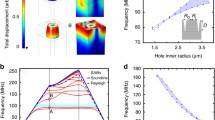Abstract
The crystal langasite manifests its unique advantages and potentials for high temperature applications due to a high electromechanical coupling coefficient, temperature compensated orientations for surface acoustic wave (SAW), and temperature stability. In order to analyze the pressure-induced frequency shift in SAW resonator type sensors at high temperature, this paper presents the electroelastic wave equations employing the effective material constants for small vibrations superimposed on biases originated from homogeneous temperature and external pressure fields in the Lagrangian description. Incorporated with the first-order perturbation integration, a model including both the mechanical and electrical perturbation items originating from thermal biases and small pressure fields is proposed. This universal model is suitable for substrate with high piezoelectricity and can be applied at either room temperature or high temperature circumstance. The criteria of optimal cuts for SAW pressure sensitivity, i.e., high electromechanical coupling coefficient and low temperature coefficient of delay, are proposed. A thorough investigation in trebly rotated cuts has shown that optimal pressure sensitive crystallographic areas can be obtained. The areas suitable for pressure sensors at room temperature are defined with Euler angles

The areas suitable for pressure sensors at high temperature are defined with Euler angles

A set of experiments employing LGS (0, 150°, 22°) and (0, 90°, 0) has been performed to check the validity of the proposed calculation. The experimental relative sensitivity is in excellent agreement with the theoretical results.
Similar content being viewed by others
References
Hornsteiner, J., Born, E., Fischerauer, G. et al., Surface acoustic wave sensors for high temperature applications, in Proc. Annu. IEEE Int. Freq. Contr. Symp., USA, IEEE Press, 1998, 615–620.
Fritze, H. et al., High temperature nanobalance sensor based on Langasite, Sensor and Actuators (B), 2001, 76(2): 103–107.
Thiele, J. A., da Cunha, M.P., High temperature surface acoustic wave devices: Fabrication and characterization, Electronics Letters, 2003, 39(10): 818–819.
Okojie, R., Operation of 6H-SiC pressure sensor at 500°C, Sensors and Actuators A, 1998, 66(3): 200–204.
Taziev, R. M., Stress, temperature and pressure behavior of SAW on langasite plates, IEEE Int. Freq. Contr. Symp., USA, IEEE Press, 2001, 227–234.
Taziev, R. M., Kolosovsky, A., Kozlov, A. S., Pressure-sensitivity cuts for surface acoustic waves in α-quartz, IEEE Trans. Ultrason. Ferroelect. Freq. Contr., 1995, 42(5): 845–849.
Tiersten, H. F., Perturbation theory for linear electroelastic equations for small fields superposed on a bias, J. Acoust. Soc. Am., 1978, 64(3): 832–837.
Sinha, B. K., Elastic waves in crystals under a bias, Ferroelectrics, 1982, 41(2): 61–73.
Bernard dulmer, Roger Bourquin, Lagrangian effective material constants for the modeling of thermal behavior of acoustic waves in piezoelectric crystals, J. Acoust. Soc. Am., 2001, 110(2): 1792–1807.
Bungo, A., Jian, C., Yamaguchi, K., Experiment and theoretical analysis of SAW properties of the Langasite substrate with euler angle (0, 140, ϕ), IEEE Ultrasonics Symposium, USA, IEEE Press, 1999, 231–234.
Sorokin, B., Turchin, P., Burkov, S. et al., Influence of static electric field, mechanical pressure and temperature on the propagation of acoustic waves in La3Ga5SiO14 piezoelectric single crystals, in Proc. IEEE Int Freq. Contr. Symp, USA, IEEE Press, 1996, 161–169.
Han, T., Ji, X., Shi, W., Langasite membranes for surface acoustic wave pressure sensors, Sensors and Materials, 2006, 18(3), in press.
Author information
Authors and Affiliations
Corresponding author
Rights and permissions
About this article
Cite this article
Tao, H., Ji, X. & Shi, W. Optimal pressure-sensitive cuts for surface acoustic waves on langasite. SCI CHINA SER F 49, 254–261 (2006). https://doi.org/10.1007/s11432-006-0254-0
Received:
Accepted:
Issue Date:
DOI: https://doi.org/10.1007/s11432-006-0254-0



